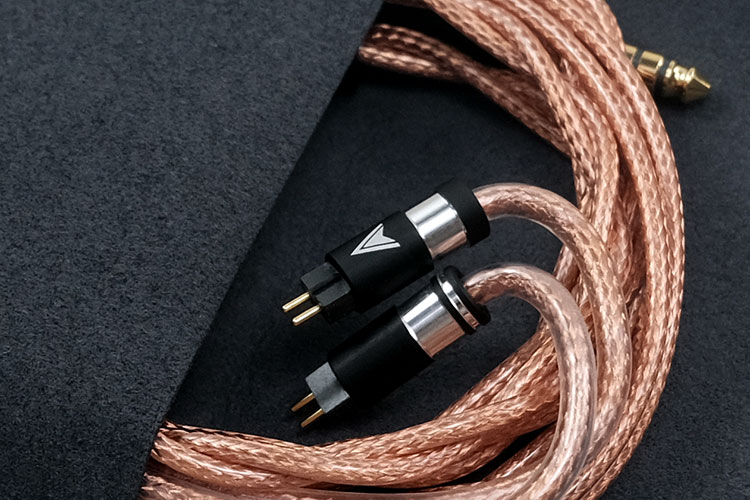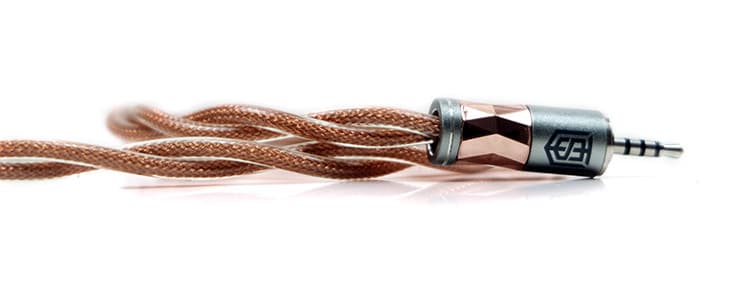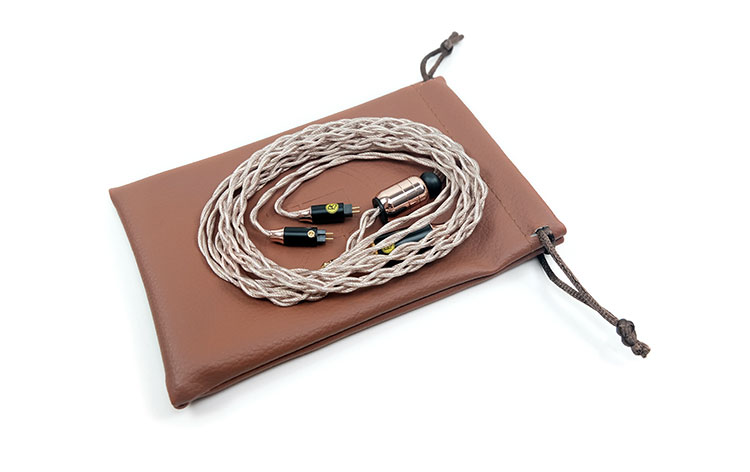Selected Comparisons
The following comparisons to the Astral Acoustics Mars were completed using a mix of the 64 Audio Trio, PMG Audio’s Apx, and the Noble Audio Kublai Khan. The iBasso DC-Elite was used for both source and amplification.
Effect Audio Code 24
The Effect Audio Code 24 was launched at the start of 2024 with our review not long after. It represents one of the more affordable Code Series cables with the accompanying and slightly cheaper Code24c.
Technical
Like Mars, Code 24 is also a two-wire coaxial-type configuration. However, I would describe it more on the extreme side of geometrical ambition with a huge 16.5AWG UP-OCC silver-plated copper Litz wire giving it a much larger physical profile compared to Mars.
All cables have a similar proprietary multi-size strand blend with Code 24 using a solid-core combined with 13 multi-sized core bundles around it and Mars using a Type 2 Litz LFOFC wire in a three-sized stranding configuration.
That solid core has some geometric considerations also, so much so, that Effect Audio has named it the Trio-Flex™ Pure Solid Core System. consists of 3 slightly smaller core wires rather than one big fat single version.
That keeps Code 24 relatively pliant despite its large AWG rating, which was a major complaint from the stiff single solid-core Code 23 version. That being said, Mars’s smaller 21AWG rating makes it way more pliant than Code 24.
Design
These are two of the most strikingly different-looking cables you could imagine. One is huge, and the other is leaner in dimensions but no shrinking violet either.
Code 24 is the ‘big blue’ with a matte EA UltraFlex jacket and a huge form factor that dwarfs the Mars mix of coppery hue from its transparent jacket. Both have a twisted finish but it’s probably the last thing you will notice when placing the cables side by side.
As such, Code 24 is bigger, less pliant, and not as easy to handle compared to Mars. The funny thing is that all that size helps emphasize the nuanced design accents. There is more cable thus you see more of the design.
Forgetting that it’s a cable, its sheer size makes the Code 24 the eye-candy choice. Once you think of cable, Mars is the better handling choice and more comfortable to wear.
It’s a similar theme with the finishing. The eye candy is with those blue and gold accented barrels on the Code 24. They are massive but attractively cut and colored and perfectly themed with the main wire jacketing.
The Mars is more subdued with its black and silver chrome finish but as a functional cable, the size is much preferred for ease of handling and socket spacing management.
Both have above-average microphonics but no surprise there since they are bigger wires and slightly stiffer. Of the two, Mars does better for physical noise deadening.
Performance
For this comparison, I went with the 64 Audio Trio as it has traditionally been always one of my most cable-sensitive IEMs
This is quite a tricky comparison because on first listening you will be hit with Code 24’s biggest asset, which is a louder sound when volume matched and a dynamic range increase from that thicker 16AWG wire.
Combine them both with that SPC wire and you get a more aggressive sound, a more vocal-focused imaging experience, and an enhanced treble presence. Code 24 sounds taller, deeper, and depending on the track, a little more holographic in its staging depth from front to back.
Mars is smoother sounding, a little fuller on the sub-bass body, warmer and more euphonic through the mids, and more relaxed through the highs though the extension is still quite good.
Vocals sit back a little with a slightly softer instrumental timbral quality and with lower levels of tonal contrast compared to Code 24’s comparatively more neutral presentation.
Of the two, Mars has a more atmospheric presentation, possibly due to the slight drop in vocal focus that creates a stronger perception of distance between the stage and the listener.
My impression of its performance with the 64 Audio Trio was a staging position slightly further back than Code 24, and slightly wider also, but not as tall and not as dynamic with its imaging.
Satin Audio Perseus
The Satin Audio Perseus was launched in mid-2022 with a unique multi-wire geometry and a similar price point to Mars.
Technical
On a high level Perseus has a similar intent to Mars with a 2-wire build using SP-OCC grade of pure copper wire and what seems to be a coaxial type of geometry. They even look relatively similar physically and use multi-sized threads of varying AWG sizes.
Digging deeper there are some nuanced differences. For example, Mars uses Long Crystal OFC copper, a type of wire typically rated above OCC for quality.
The average AWG rating of the Mars wiring is 21AWG as opposed to Perseus’s dual wire mix of 26AWG and 23AWG. The Litz rating is Type 2 as opposed to the Perseus Type 1 and the Mars uses a passive isolation technique as opposed to Satin Audio’s SA UltraSoft materials.
Design
I find these two cables to be very similar visually with the barrels being the major difference in aesthetics.
It is ironic, however, that despite Mars using the larger 21AWG gauge wire in its coaxial geometry it is the Perseus cable that feels the stiffer of the two for wearing.
I put that down to two observable reasons; the choice of a bulkier jacket material and a more elongated twisting technique which imbues the Perseus with a stiffer and thicker quality in its handling.
The Mars twisting is tighter with a lighter transparent jacket making it one of the more malleable coaxial cables to date for handling.
The Perseus has a more creative finish with a striking isosceles triangle bevel and copper-accented design in the middle of the splitter and plug barrels. Mars barrels are of a similar dimension but with a more muted or conservative black and silver.
There will be preferences for both but I find the Pereus finish more integrated and capped off by a chin cinch of a higher-quality aluminum finish compared to the simpler silicone grommet on Mars.
Performance
For this face-off, I went with Noble Audio’s Kublai Khan, a dynamic-sounding hybrid with plenty of treble-infused contrast that can get quite bright if poorly matched. I tend to go with copper cables with the Khan and the Viking Ragnar for long listening sessions.
I can tell you to get Mars over Perseus if you are sensitive to that 5-6k peak from the Kublai Khan. Not only does it inject more warmth into the midrange instrumental notes and general vocal performance but there is a more satisfying solidity to the low-end, particularly the sub-bass performance.
The Perseus seems to allow a bit more treble presence and slightly less warmth from the lows. Arguably it is more balanced and what you get from the Kublai Khan might seem ‘truer’ as a result.
And yes, it still maintains a sweet enough sound but notes are noticeably leaner when compared to Mars. The Kublai Khan can sound brighter and thinner through the upper mids with the Perseus.
I would rate the Perseus as the taller of the two for staging headroom with the Mars deeper and slightly wider. Like the Code 24 comparison, Mars’s vocal positioning is relatively more relaxed compared to Perseus.
That vocal positioning is a much better match for my preferences when listening to Kublai Khan. That relaxing presentation is almost perfect for this pairing.
The slightly larger gauge Mars also has a very slight edge in terms of dynamic range though volume differences between the two are minimal using the HiBy R8 II balanced output in Turbo mode.
PLUSSOUND Quad-Copper
The PLUSSOUND Quad Copper is a limited-run cable launched in early 2023. It’s one of my favored options for bright-sounding IEMs and has a price point not far off Mars.
Technical
You could argue that Quad Copper has more of a traditional 4-wire geometry combined with one of the most exotic mixes of copper out there.
This cable includes UP-OCC copper, silver-plated copper, and gold-plated copper, with an additional palladium-plated copper element. OCC is TOTL in terms of purity but given the wide mix of elements, it would be hard to tell if it’s a dominant performer.
Mars’s 2-wire coaxial geometry is more ‘in vogue’ when compared to the PLUSSOUND Type 6 implementation. However, there is a twist with Quad Copper’s implementation, with two bundles of every material per main bundle instead of one with proprietary dampening cores in each wire.
One final note is their respective AWG rating with Mars noticeably thicker at 21AWG and the Quad Copper using a classic 26AWG 4-wire design. That does have ramifications for their respective handling properties.
Design
The Quad Copper is a classic aftermarket IEM cable design with a tight braiding structure as opposed to twisted and very malleable handling qualities as a result
Given Quad Copper’s mix of materials, it’s no surprise the aesthetical tone is paler. This is more of a rose-gold visual rather than the deeper copper tone of Mars but if you do look closely you can see some of the subtle variable colorings in the mix of wiring under the translucent jacket.
I like that rose-gold sheen of the wiring, it’s a perfect complement to the matching rose-gold hot-stamped metallic heat shrinks on both the black connector and jack barrel. It’s a very harmonious look and one that will attract a fair degree of attention. This is not an understated color scheme for sure.
I will give props to PLUSSOUND also for the barrel finishing. The barrel designs are among the toughest in the industry whilst still creating a nice complimentary vibe to the main jacket color scheme.
Mars barrels come close but I would lose to see that hot stamping on the top of the jack and connector barrels as they create a neater presentation than the current open-top finish.
The Quad Copper does have a handling advantage over Mars but that should not be a surprise given it has a smaller wire gauge combined with traditional braiding. Both use pleasingly soft jacketing material so the comfort levels around the ear are not that far apart.
Performance
I went with the PMG Audio Apx for this match-up. It’s a huge-sounding hyper-detailed performer but can have a spicy top end when paired poorly.
Normally I go copper or stock cable for this so it felt like common ground for both the Quad Copper and Mars.
Mars’s larger AWG rating is a difference maker with the Apx sounding more forceful and dynamic. It also does a better job fleshing out the Apx’s vast soundstage, particularly on the X-Axis with more lingering spatial cues making their presence felt on the extreme ends of the spectrum.
The Quad Copper has a bit more bass-to-mids separation with the Apx lower-mids sounding relatively subdued along with a narrower soundstage compared to Mars.
It does not have quite the same level of mid-bass bloom and warmth on the lows though it does sound quite dense for sub-bass presence. The Quad Copper lows sound a bit tighter with slightly shorter note decay compared to the languid, decay-heavy Mars/Apx sub-bass performance.
With a reduced level of bass bloom and a slightly stronger lower-treble coloration, the Quad Copper mids can sound comparatively more neutral. Not so much as to create any sharpness but just a shade more contrast in the midrange timbre.
I could take either cable with the PMG Audio Apx. Neither creates a lean unnatural tonal quality. Go with Mars if you want a more flamboyant richer performance or stick with Quad Copper if you want to calm it down a touch.
My Verdict
The Astral Acoustics Mars performs exactly how you would expect a proper copper cable to do with a welcoming rich and euphonic quality perfectly suited to bright-sounding IEMs.
As a bonus, it delivers excellent staging width and an above-average level of dynamic range compared to smaller gauge aftermarket cables of a similar price point.
Yes, it is slightly stiffer than some alternatives with slightly higher than average microphonics. I have never found a coaxial cable with this AWG size or higher to be a star pupil for handling. However, Astral Acoustics has done an excellent job with the soft jacketing keeping it more malleable than I expected.
Overall, Mars is a competitive performer, but more importantly, it has a distinct and memorable performance identity with my tested IEMs, making it an easy recommendation for treble-sensitive audiophiles.
Astral Acoustics Mars Technical Specifications
- Material: Long Crystal Copper
- Length: 120cm
- Build time: 1 week with 50hrs+ burn-in
- 3 Year Warranty





